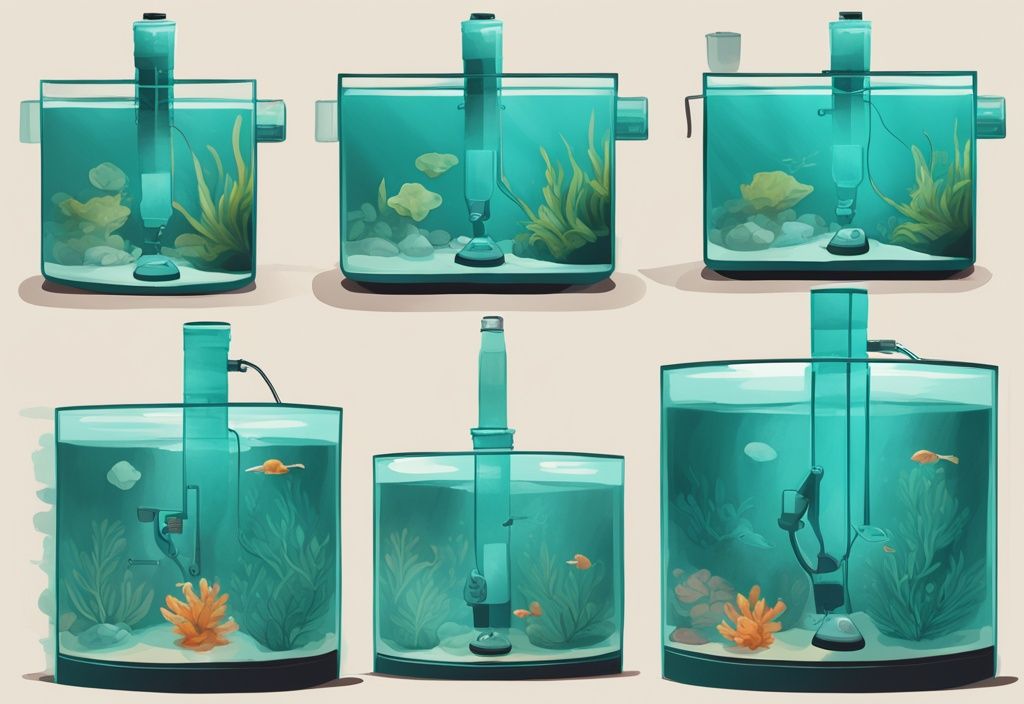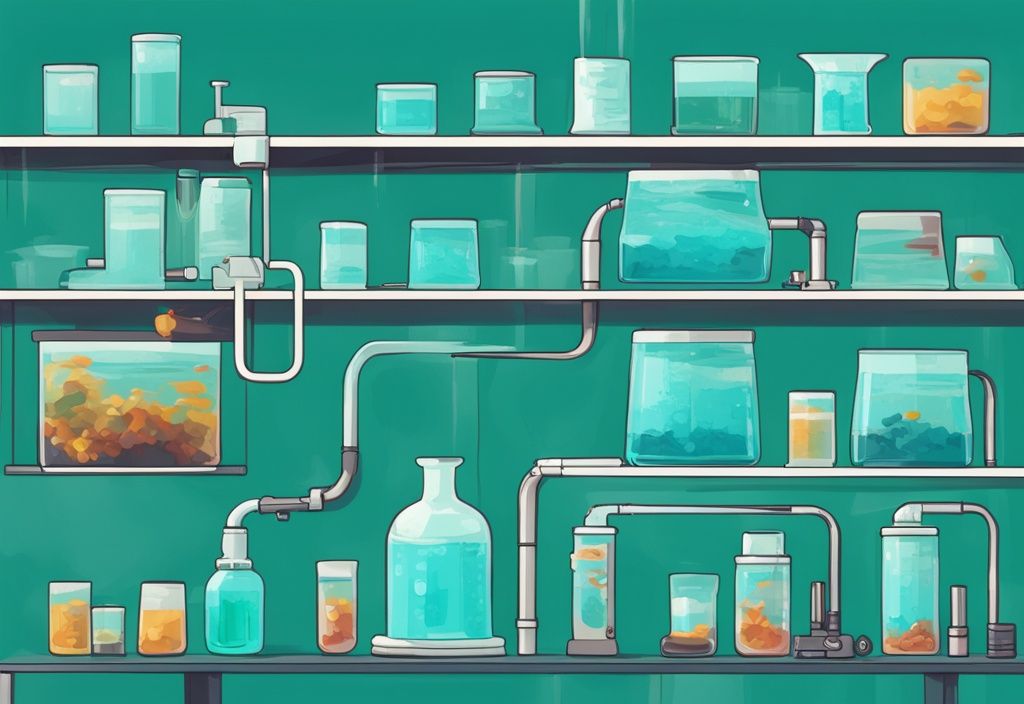Ever wondered about the silent enemy lurking unseen in your aquarium? Yes, it is the General Hardness (GH) levels impacting your fish’s wellbeing and harmony of your aquatic ecosystem. As a marine biologist, I’ve seen first-hand how high GH levels can upset the balance of life within a tank, triggering health issues in fish and plants.
In this comprehensive guide, I’m about to journey with you into uncovering the secrets of managing and lowering GH in your aquarium. Expect to delve into the art of testing techniques, harness the potential of natural and commercial solutions, every detail, no stone unturned.
Make no mistake, it’s more than just a guide– it’s your beacon of wisdom as you navigate your way to a thriving, vibrant fish tank. Ready to dive in?
Understanding What is GH (General Hardness) in an Aquarium
GH (General Hardness) measures the concentration of calcium and magnesium ions in aquarium water. These ions play a critical role in the biological functions of both fish and plants, supporting a variety of essential processes like bone formation in fish and enzymatic activities in plants.
For freshwater aquariums, maintaining the ideal GH levels is paramount. Typically, these levels fall within the range of 60-160 ppm. Deviating from this range can significantly impact the health and stress levels of your aquarium’s inhabitants. High or low GH levels can cause stress and compromise the immune systems of fish, making them more susceptible to diseases.
The Importance of Maintaining Ideal GH Levels
One of the key aspects of aquarium maintenance is ensuring that GH levels are appropriate for the species you are keeping. Certain fish species, such as those that thrive in soft water environments like Discus and Neon Tetras, can experience stress and health issues in high GH conditions.
Conversely, fish that naturally inhabit hard water environments, like African Cichlids, require higher GH levels to thrive.
Maintaining ideal GH levels is not merely about the comfort of your fish; it also plays a vital role in facilitating healthy biological functions. This includes everything from skeletal development in fish to nutrient absorption in aquatic plants.
An optimal GH level creates a stable and suitable living environment, reducing stress and preventing diseases among your aquarium’s inhabitants. By understanding how to lower GH in aquarium effectively, you can ensure a balanced and healthy ecosystem for both fish and plants.
Testing Your Aquarium’s GH Levels Today
Ensuring the proper General Hardness (GH) levels in your aquarium is vital for the health and well-being of your aquatic inhabitants. The following sections will guide you through testing and maintaining the optimal GH levels.
How to Use a GH Test Kit?
Using a GH test kit, readily available at most pet stores and online, is an essential part of maintaining your aquarium’s health. Think of it as the equivalent of a health check-up for your aquarium. To start, reach for your GH test kit and follow the provided instructions. Typically, this process is akin to a simple science experiment that involves taking a water sample from your aquarium.

After collecting your sample, you’ll add a reagent drop by drop into it. Here’s where it gets interesting—after each drop, give the sample a little shake and keenly watch for a color change. The instructions will detail the specific color you need to look for as it will indicate the endpoint of your test.
The number of drops you use to achieve this color change is crucial. Count them carefully as they will help you determine the GH level of your water. Whether your results are measured in degrees of General Hardness (dGH) or parts per million (ppm), the process is straightforward. For instance, if it takes 5 drops to see the color change, and each drop represents 20 ppm, your GH level is 100 ppm. It’s a simple, yet effective way to get a snapshot of your aquarium’s health.
How often should you Test?
Regular testing is the cornerstone of a stable and healthy aquarium environment. Testing your aquarium’s GH levels at least once a month is advisable. This regularity helps you catch any fluctuations early and allows for timely adjustments if needed.
However, if you notice any unusual changes in your fish’s behavior or the health of your plants, it’s wise to increase the frequency of your testing. More frequent tests become particularly crucial when you’re actively working on adjusting GH levels. Just like a chef constantly tastes their dish during cooking, you need to monitor these changes carefully to ensure they are progressing as desired.
By regularly testing your GH levels, you ensure your aquarium’s inhabitants are living in optimal conditions. This consistent monitoring helps you preemptively address any potential issues, providing peace of mind. This practice is essential for anyone looking to understand how to lower GH in an aquarium effectively.
Efficient Methods to Lower GH in Aquarium
How to Implement Water Changes with Soft Water
Opting for Distilled, Deionized, or Reverse Osmosis Water
Using soft water sources like distilled, deionized, or reverse osmosis (RO) water is a highly effective method to lower GH in an aquarium.
These water types have minimal to no mineral content, which helps to reduce the concentration of calcium and magnesium ions when used in water changes. Among them, RO/DI water is particularly beneficial, as it thoroughly removes salts, minerals, and other contaminants, ensuring a purer form of water suitable for sensitive aquatic life.
The Balance of Mixing Tap Water with RO/DI Water
Achieving the right GH levels often involves mixing RO/DI or distilled water with tap water. This balanced approach allows for the customization of water hardness to meet the specific needs of your fish and plants. It is essential to introduce these changes gradually to avoid stressing the aquarium inhabitants. Monitoring the mixture ensures that it consistently meets the required standards, maintaining a healthy environment for aquatic life.

Discover Natural Methods to Lower GH
Adding Peat Moss: Advantages and Risks
One natural method for lowering GH in aquarium water is incorporating peat moss into the filtration system or substrate. Peat moss acts as an ion-exchanger, releasing tannins and humic acids, which help reduce GH. However, there are some risks: the water may acquire a yellow tint, and the pH levels could be affected. Careful monitoring is necessary to maintain balance within the aquarium ecosystem.
Utilizing Driftwood to Naturally Lower GH
Driftwood can also be employed to naturally lower GH levels in an aquarium. It releases tannic acids into the water, which gradually soften it by decreasing the mineral content. This method offers a natural, chemical-free alternative to lowering GH, and the presence of driftwood can enhance the aesthetic appeal of the aquarium.
Can Rainwater and Tap Water Mix Make a Difference?
Mixing rainwater with tap water can be an efficient way to lower GH in an aquarium. Rainwater typically has very low GH, making it a beneficial addition. However, it is crucial to ensure that the rainwater is free from pollutants before using it in your aquarium. This method provides a cost-effective solution for reducing GH levels, but it requires careful quality control.
Commercial Products Available for Lowering GH
The Use of Water Softening Pillows or Resin-Based Products
Commercial products such as water softening pillows or resin-based products are specifically designed to lower GH by removing calcium and magnesium ions from the water. These products can be very effective but need to be used with caution to avoid imbalances in other water parameters. Regular testing ensures that the aquarium’s environmental conditions remain stable and suitable for its inhabitants.
Weighing the Pros and Cons of Commercial GH Reducers
Commercial GH reducers can offer immediate and noticeable effects, making them convenient and easy to use without necessitating large water changes. However, these products often exchange calcium and magnesium ions for sodium ions, which may cause stress for some fish species. It’s essential to weigh these pros and cons and monitor the water chemistry closely when employing these solutions.
Gradual Reduction Techniques Explained
The Impact of Gradual Water Changes
Lowering GH gradually through small, frequent water changes using soft water is a practical approach to avoid sudden shifts in water hardness. This technique helps in preventing shock and stress in fish, maintaining a stable environment. Regularly monitoring GH levels ensures that these gradual changes achieve the desired effect without causing harm to the aquarium’s inhabitants.
How Introducing Live Plants Can Help?
Incorporating live plants into your aquarium can naturally help lower GH over time. Plants absorb minerals from the water, gradually reducing the GH. Species like hornwort and water sprite are particularly effective at absorbing excess minerals and can be a valuable addition to the tank for this purpose.
The Effect of Replacing Calcium-Rich Substrates
Substrates composed of materials like coral or seashells can increase GH levels due to their high calcium content. Replacing such substrates with inert materials like sand or gravel can help maintain lower GH levels. This switch not only controls water hardness but also contributes to a more stable and suitable environment for your aquarium’s inhabitants.
Monitoring and Maintaining GH Levels: A Checklist
Maintaining the right GH (General Hardness) levels in your aquarium is essential for creating a stable and healthy environment for your aquatic friends. Here’s everything you need to know to keep GH in check and foster a balanced ecosystem.
The Correlation Between Stable KH, pH Levels, and GH
Understanding the interplay between GH, KH, and pH levels is crucial for anyone looking to lower GH in an aquarium. GH directly influences these parameters. KH, or Carbonate Hardness, acts as a buffer, stabilizing pH and preventing drastic changes that could stress your aquatic life. When GH levels are high, stabilizing pH and KH can become a more challenging task. Regular monitoring and precise adjustments ensure that these parameters remain within safe ranges, promoting an optimal habitat for your fish and plants.
Importance of Regular Testing and Selecting Reliable Kits
Continuous monitoring is vital for managing GH levels effectively. Investing in reliable GH test kits or TDS meters is indispensable for this purpose. Opt for kits known for their accuracy, as these will help detect even minor fluctuations. Regular testing should become a habit; ideally, you should test your water once a month. With early detection of changes, you can take prompt action to maintain ideal GH levels, preventing stress and health problems in your aquatic inhabitants.
How to Monitor for Changes and Maintain Aquarium Health?
Implementing a systematic routine for GH testing will help maintain a stable environment. Keep a close eye on your fish and plants; any changes in their behavior or health can signal shifts in GH levels needing attention. Maintaining detailed records of your test results is invaluable, allowing you to spot trends and make informed decisions on steps to lower GH in your aquarium. Implementing gradual adjustments based on these insights ensures a stable and healthy habitat for all your aquarium’s inhabitants.
Best Practices for Lowering and Maintaining GH for Long-term Results
Ensuring balanced GH (General Hardness) levels in your aquarium is crucial for the well-being of both fish and plants. Implementing proper practices for lowering and maintaining GH can lead to a healthier and more vibrant aquatic environment. Let’s delve into effective strategies to achieve and sustain optimal GH levels.
Safely Acclimating Fish to New GH Levels
Acclimating fish to new GH levels is vital for preventing stress and physiological shock. Consider utilizing drip acclimation methods. This technique involves a slow introduction of fish to new water conditions over several hours. Proper acclimation is essential, especially if you’re looking to maintain stable water parameters. If you’re also interested in learning how to raise KH in your aquarium, you can enhance your fish’s environment significantly. By employing a slow dripping system where water from the tank is gradually poured into the container holding the new fish, you ensure a gentle transition. This gradual adjustment helps fish adapt to changes in mineral levels, reducing stress and potential health issues. It’s essential to monitor fish behavior during the acclimation process to ensure they are adjusting comfortably.
Knowing Your Species: A Key to Ideal GH Levels
Different fish and plant species have unique GH preferences. Research is essential to cater to the specific needs of your aquarium inhabitants. For example, soft water fish like tetras and discus thrive in lower GH levels, whereas cichlids prefer harder water. Similarly, certain plants flourish within specific GH ranges. Understanding these preferences allows you to tailor your GH management strategy effectively. Utilize resources such as species profiles and aquarium guides to gather detailed information, ensuring an optimized environment tailored to your fish and plants’ needs.
How to Maintain a Stable Aquarium Environment
Maintaining consistent water parameters is crucial for the health and well-being of your aquarium inhabitants. Regular maintenance tasks, such as weekly water changes and substrate cleaning, help in keeping GH levels stable. Avoid abrupt changes in water composition to prevent stress in your fish. Using a water conditioner can also aid in stabilizing key parameters. Establish a routine for monitoring GH, KH, and pH levels, and strive to address any imbalances promptly. Consistency in these practices ensures a thriving and stable aquarium ecosystem.

The Role of Specific Plants in Absorbing Excess Minerals
Incorporating specific aquatic plants into your aquarium can effectively manage GH levels. Plants like hornwort and water sprite are known for their ability to absorb excess minerals from the water. These plants not only contribute to reducing GH but also enhance overall water quality by providing oxygen and reducing nitrate levels. Planting a sufficient number of these species can create a natural system for lowering GH, minimizing the need for chemical additives. Regular pruning and maintenance of these plants ensure they remain healthy and continue to serve their purpose effectively.
By following these practices, you can achieve a harmonious and balanced aquarium environment, ensuring the long-term health and vitality of your aquatic inhabitants.
Conclusion
Maintaining ideal GH levels in your aquarium is crucial for the well-being of both fish and plants. GH, or General Hardness, measures the concentration of calcium and magnesium ions in the water. These ions are essential for various biological functions and overall health. The ideal GH range for freshwater aquariums is generally between 60-160 ppm, depending on the specific needs of the inhabitants.
When GH levels are too high or too low, it can induce stress and make fish more susceptible to diseases. Therefore, understanding how to lower GH in an aquarium is essential for creating a stable and healthy environment. Fortunately, various methods can help you achieve and maintain the optimal GH levels.
One effective approach to lowering GH is by using soft water such as distilled, deionized, or reverse osmosis (RO) water. These types of water have low mineral content and can be mixed with tap water to reach the desired GH.
Another method is the use of natural materials, like peat moss or driftwood, which can soften water by releasing tannic and humic acids.
Commercial products such as water softening pillows or resin-based products are also available and can provide immediate results. However, these should be used cautiously as they might alter other water parameters.
Consistency in water changes, incorporating live plants that absorb excess minerals, and removing calcium-rich substrates are additional strategies to control and lower GH levels.
Regular testing of GH is crucial to ensure the environment remains stable and suitable for all aquarium inhabitants.
A well-balanced GH level not only promotes the health and longevity of fish and plants but also enhances the overall quality and enjoyment of the aquarium. By understanding and implementing the right methods, you can create a vibrant and thriving aquatic ecosystem that provides a stress-free habitat for your aquatic life.
FAQs: Your Key Questions Answered
What is the ideal GH level for freshwater aquarium?
The ideal GH (General Hardness) level in a freshwater aquarium varies depending on the species of fish and plants you keep. Generally, a range between 60-160 ppm is optimal. This range ensures that your aquatic life enjoys a habitat that supports healthy biological functions. For instance, soft water fish like tetras thrive at the lower end, whereas cichlids prefer harder water.
How often should I test GH levels in my aquarium?
Regular monitoring of GH levels is crucial. I recommend testing at least once a month to ensure your aquarium maintains a stable environment. However, if you’re making adjustments or notice changes in your fish’s behavior or plant health, it’s wise to increase the frequency. Think of it like your routine health check-up—it’s always better to catch potential issues early.
Can tap water be used to lower GH levels?
Interestingly, tap water alone usually won’t lower GH levels. Tap water typically contains minerals that contribute to hardness. Instead, you can blend tap water with reverse osmosis (RO) water, distilled water, or even collected rainwater for better control over your aquarium’s GH. This method allows precise adjustments, making it easier to reach your desired water hardness.
What are the risks associated with using peat moss or driftwood to lower GH?
Using natural methods like peat moss or driftwood can indeed help lower GH, but it’s not without its challenges. Peat moss, for example, can tint your water a tea-like yellow and potentially alter pH levels. Driftwood, on the other hand, releases tannins that reduce hardness but also darken the water. Both methods necessitate close monitoring to ensure you don’t experience unwanted chemical imbalances. It’s a delicate balance—like making a perfect cup of tea—too much of either can skew your aquarium’s equilibrium.
How do commercial GH reducers work and are they safe?
Commercial GH reducers can be quite effective and are designed to simplify the process of lowering GH. They typically work by exchanging calcium and magnesium ions for sodium ions. While this method can be safe, it’s essential to follow the manufacturer’s instructions carefully. Overuse or incorrect application can lead to chemical imbalances, making your aquarium less hospitable for your fish and plants. For more information on managing these imbalances, check out our guide on how to lower alkalinity in a fish tank. Always think of these products as more like precision tools rather than broad strokes on a canvas—careful and limited application usually yields the best results.
